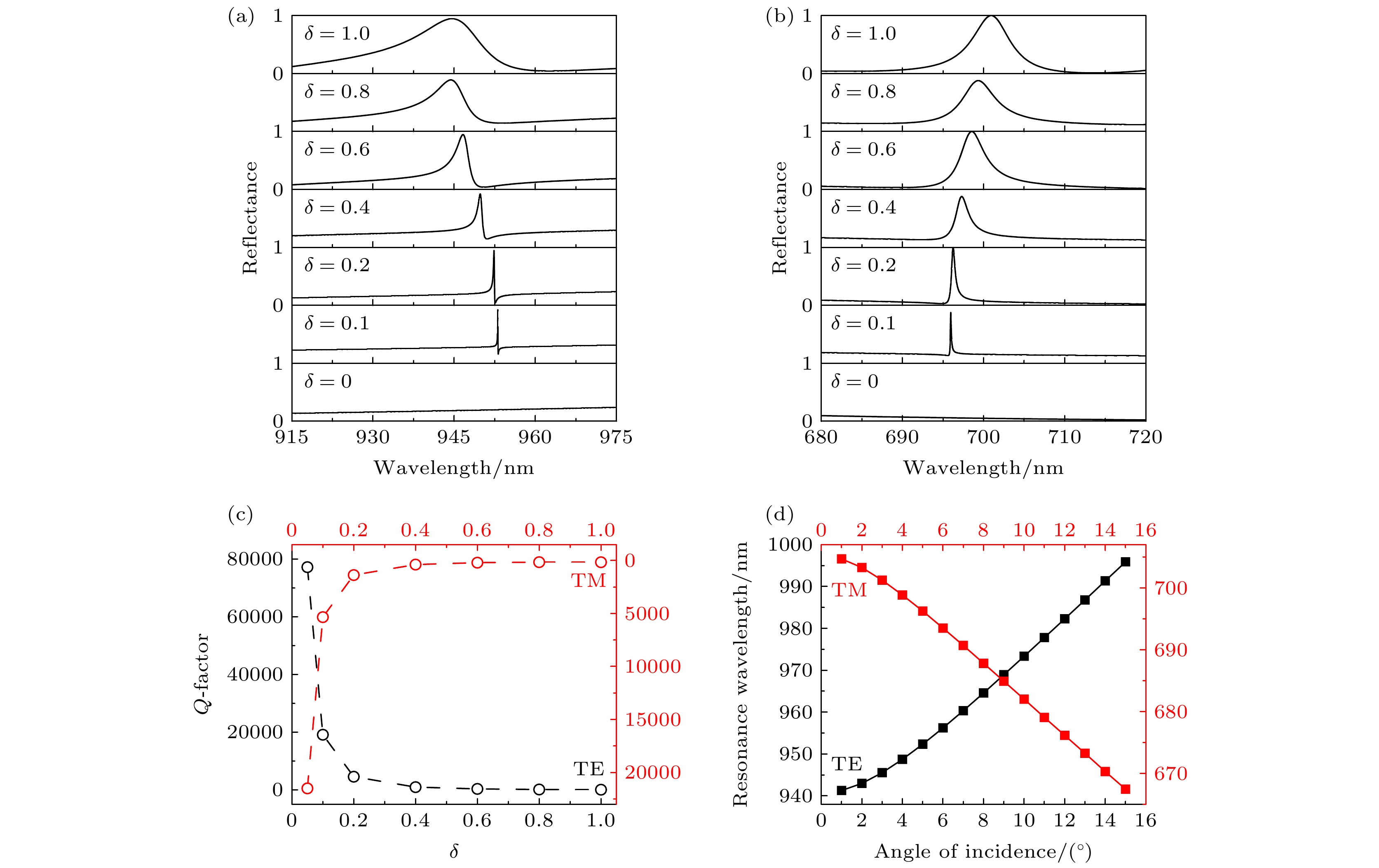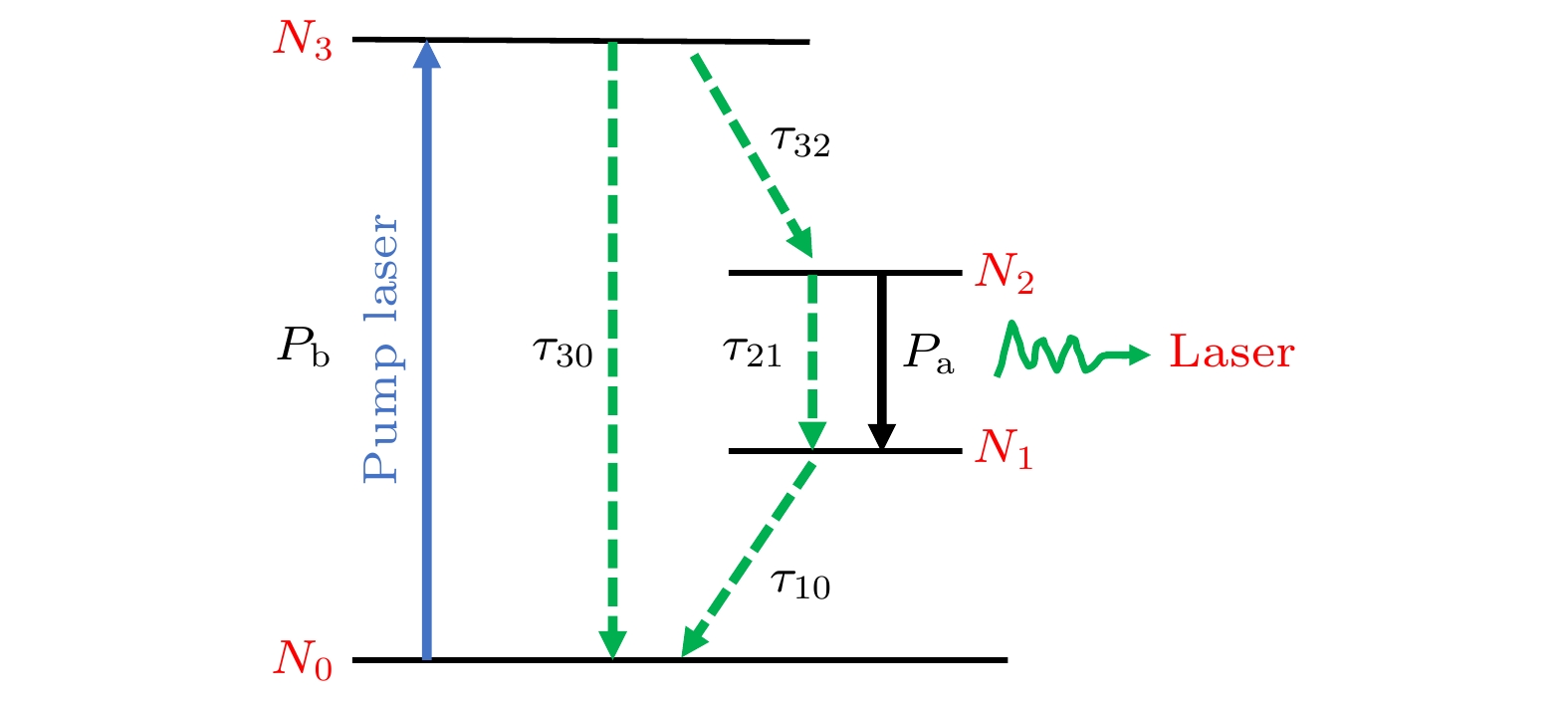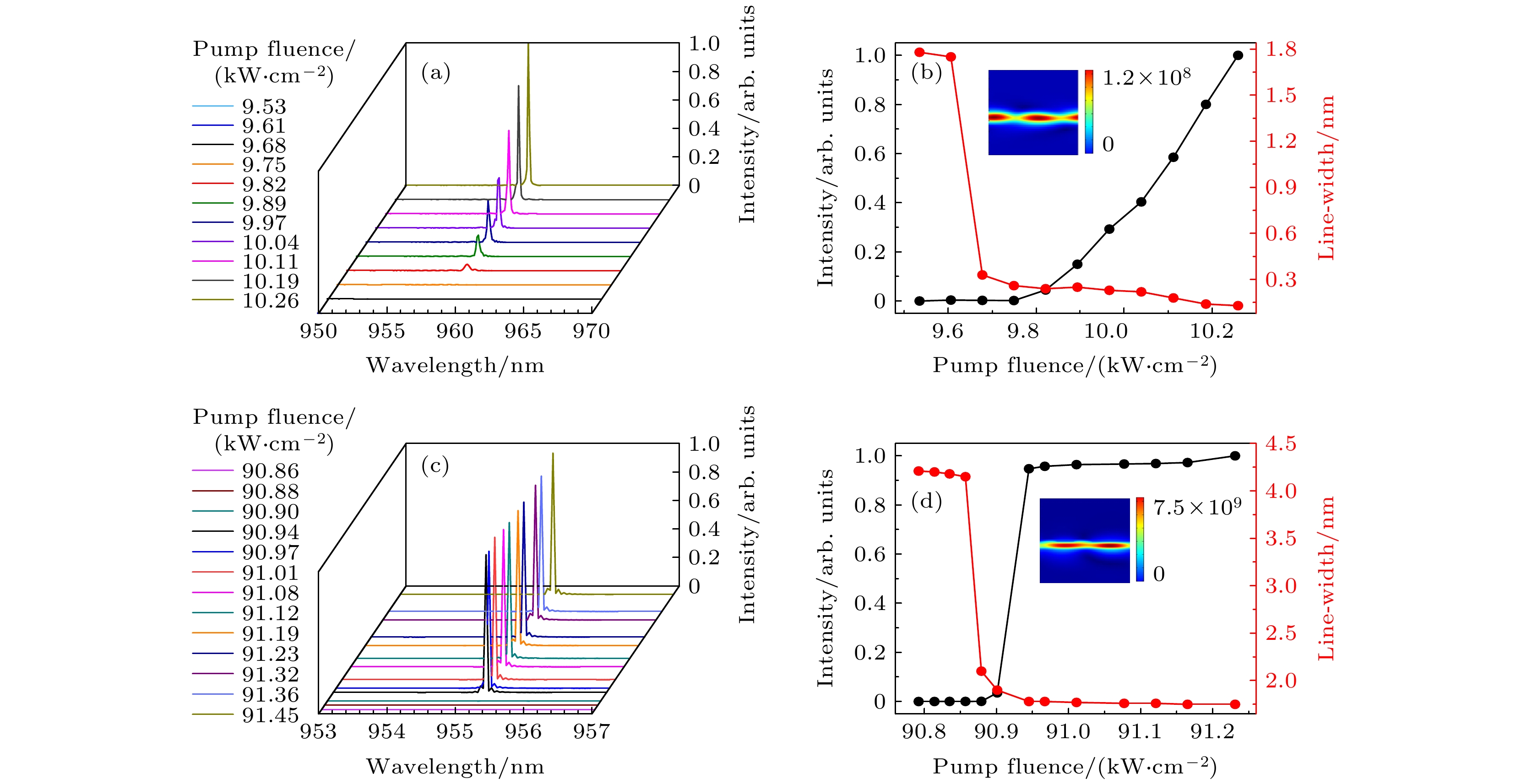-
纳米激光作为一种纳米级相干光源,是光电集成芯片的关键器件. 激光器进一步小型化的阻碍在于随着激光器谐振腔体积的减小, 其损耗迅速增大. 连续域束缚态(bound states in the continuum,BICs)能有效降低全介质结构的辐射损耗. 本文提出一种基于全介质共振波导光栅(resonant waveguide grating structures, RWGs)准BIC的纳米激光器,可有效降低纳米激光器的阈值. 将传统两部分光栅转换为四部分光栅,可激发波导结构的准BIC模式. 本文数值研究了该模式的受激辐射放大特性. 结果表明: TE偏振光照射下, 基于四部分光栅的RWG结构的纳米激光阈值比基于传统RWG结构的阈值低20.86%. TM偏振光照射时, 阈值比传统RWG结构降低了3.3倍. 而且TE偏振光照射时纳米激光的阈值比TM偏振光照射时阈值大约低一个数量级, 这是因为TE偏振光照射时,结构的电场局域在波导层内, 增强了光与增益材料的相互作用, 从而降低了纳米激光的阈值.As a nanoscale coherent light source, semiconductor nanolaser is a key device for future optoelectronic integrated chips. The obstacle of further miniaturization of the nanolaser is that the loss increases rapidly with the decrease of cavity volume. The bound states in the continuum (BICs) can overcome the high radiative loss. Here, we propose a nanolaser based on quasi-BIC mode supported by all-dielectric resonant waveguide grating (RWG), which can effectively reduce the threshold of nanolaser. The quasi-BIC mode of the waveguide can be excited when the traditional two-part grating becomes a four-part grating. The laser behavior of the quasi-BIC is studied by finite difference-time-domain (FDTD) numerical simulation. The results show that the threshold of the naolaser based on four part-grating RWG is 20.86% lower than that of nanolaser based on two part-grating RWG when subjected to TE-polarized light irradiation. For the TM-polarized light irradiation, the threshold is 3.3 times lower than the threshold for the nanolaser based on four part-grating RWG. We also find that the threshold of the nanolaser under TE-polarized light irradiation is about one order of magnitude lower than that under TM-polarized light irradiation. Because the electric field of the structure is well confined inside the waveguide layer under TE-polarized light, which can enhance the interaction between light and gain materials and reduce the threshold of nanolasers.
-
Keywords:
- bound states in the continuum (BICs) /
- nanolaser /
- low-threshold /
- Q-factor
[1] Li C, Liu Z, Chen J, Gao Y, Li M L, Zhang Q 2019 Nanophotonics 8 2091
 Google Scholar
Google Scholar
[2] Du W, Li C H, Sun J C, Xu H, Yu P, Ren A B, Wu J, Wang Z M 2020 Laser Photonics Rev. 14 2000271
 Google Scholar
Google Scholar
[3] Ma R M, Oulton R F 2019 Nat. Nanotechnol. 14 12
 Google Scholar
Google Scholar
[4] Saxena D, Mokkapati S, Jagadish C 2012 IEEE Photon. J. 4 582
 Google Scholar
Google Scholar
[5] Moitra P, Slovick B A, Li W, Kraychencko II, Briggs D P, Krishnamurthy S, Valentine J 2015 ACS Photonics 2 692
 Google Scholar
Google Scholar
[6] Bi K, Wang Q M, Xu J C, Chen L H, Lan C W, Lei M 2021 Adv. Opt. Mater. 9 2001474
 Google Scholar
Google Scholar
[7] Qiu J L, Liu X Y, Liang Z Z, Zhu J F 2021 Opt. Lett. 46 849
 Google Scholar
Google Scholar
[8] Jahani S, Jacob Z 2016 Nat. Nanotechnol. 11 23
 Google Scholar
Google Scholar
[9] Ma Z J, Hanham S M, Albella P, Ng B H, Lu H T, Gong Y D, Maier S A, Hong M H 2016 ACS Photonics 3 1010
 Google Scholar
Google Scholar
[10] Tian J Y, Li Q, Belov P A, Sinha R K, Qian W P, Qiu M 2020 ACS Photonics 7 1436
 Google Scholar
Google Scholar
[11] Neuman J V, Wigner E 1929 Phys. Z 30 467
 Google Scholar
Google Scholar
[12] Friedrich H, Wintgen D 1985 Phys. Rev. A 32 3231
 Google Scholar
Google Scholar
[13] Bogdanov A A, Koshelev K L, Kapitanova P V, Rybin M V, Gladyshev S A, Sadrieva Z F, Samusev K B, Kicshar Y S, Limonov M F 2019 Adv. Photonics 1 016001
 Google Scholar
Google Scholar
[14] Joseph S, Pandey S, Sarkar S, Joseph J 2021 Nanophotonics 10 4175
 Google Scholar
Google Scholar
[15] Zhang Y B, Liu W W, Li Z C, Li Z, Cheng H, Chen S Q, Tian J G 2018 Opt. Lett. 43 1842
 Google Scholar
Google Scholar
[16] Huo Y Y, Zhang X, Yan M, Sun K, Jiang S Z, Ning T Y, Zhao L N 2022 Opt. Express 30 19030
 Google Scholar
Google Scholar
[17] Foley J M, Young S M, Phillips J D 2014 Phys. Rev. B 89 165111
 Google Scholar
Google Scholar
[18] Zhang M D, Zhang X D 2015 Sci. Rep. 5 8266
 Google Scholar
Google Scholar
[19] 杜芊, 陈溢杭 2021 物理学报 70 154206
 Google Scholar
Google Scholar
Du Q, Chen Y H 2021 Acta Phys. Sin. 70 154206
 Google Scholar
Google Scholar
[20] Yang J H, Huang Z T, Maksimov D N, Pankin P S, Timofeev I V, Hong K B, Li H, Chen J W, Hsu C Y, Liu Y Y, Lu T C, Lin T R, Yang C S, Chen K P 2021 Laser Photonics Rev. 15 2100118
 Google Scholar
Google Scholar
[21] Kodigala A, Lepetit T, Gu Q, Bahari B, Fainman Y, Kante B 2017 Nature 541 196
 Google Scholar
Google Scholar
[22] Hwang M S, Lee H C, Kim K H, Jeong K Y, Kwon S H, Koshelev K, Kivshar Y, Park H G 2021 Nat. Commun. 12 4135
 Google Scholar
Google Scholar
[23] Azzam S I, Chaudhuri K, Lagutchev A, Jacob Z, Kim Y L, Shalaev V M, Boltasseva A, Kildishev A V 2021 Laser Photonics Rev. 15 2000411
 Google Scholar
Google Scholar
[24] Bi W L, Zhang X, Yan M, Zhao L N, Ning T Y, Huo Y Y 2021 Opt. Express 29 12634
 Google Scholar
Google Scholar
[25] Zhang H R, Wang T, Tian J Y, Sun J C, Li S X, De Leon I, Zaccaria R P, Peng L, Gao F, Lin X, Chen H S, Wang G F 2022 Nanophotonics 11 297
 Google Scholar
Google Scholar
[26] Ning T Y, Li X, Zhao Y, Yin L Y, Huo Y Y, Zhao L N, Yue Q Y 2020 Opt. Express 28 34024
 Google Scholar
Google Scholar
[27] Wu F, Wu J J, Guo Z W, Jiang H T, Sun Y, Li Y H, Ren J, Chen H 2019 Phys. Rev. Appl. 12 014028
 Google Scholar
Google Scholar
[28] Liu W X, Li Y H, Jiang H T, Lai Z Q, Chen H 2013 Opt. Lett. 38 163
 Google Scholar
Google Scholar
[29] Quaranta G, Basset G, Martin O J F, Gallinet B 2018 Laser Photonics Rev. 12 1800017
 Google Scholar
Google Scholar
[30] Adachi S 1989 J. Appl. Phys. 66 6030
 Google Scholar
Google Scholar
[31] Yariv A, Yeh P 1984 Optical Waves in Crystals ( New York: Wiley)
[32] Sun K L, Jiang H, Bykov D A, Van V, Levy U, Cai Y J, Han Z H 2022 Photonics Res. 10 1575
 Google Scholar
Google Scholar
[33] Chang S H, Taflove A 2004 Opt. Express 12 3827
 Google Scholar
Google Scholar
[34] Zhao Y W, Dong Z Y, Miao S S, Deng A H, Yang J, Wang B 2006 J. Appl. Phys. 100 123519
 Google Scholar
Google Scholar
-
图 2 波导层中TE0(a)和TM0(b)导模的色散关系曲线(黑色实线), 以及在不同入射角下的kx = kx, i (i = –1, –2)色散曲线, 1° (红色虚线), 5° (绿色虚线), 10° (蓝色虚线), 15° (青色虚线).
Fig. 2. Dispersion relations of the TE0 guide mode (a) and TM0 guide mode (b) in the waveguide layer (black solid line), and kx = kx, i (i = –1, –2) under different angle of incidence, 1° (red dashed lines), 5° (green dashed lines), 10° (blue dashed lines), 15° (cyan dashed lines), respectively.
图 3 (a)(b) θ = 5°时, 不同几何参数δ下的RWG结构在TE(a)和TM(b)偏振光照射下λA的反射谱; (c)在TE和TM偏振光照射下RWG结构的Q因子与δ的函数关系; (d) δ = 0.2时RWG结构分别在TE和TM偏振光照射下的共振波长与入射角的关系
Fig. 3. (a)(b) Reflection spectra near λA of the RWG structure for different geometric parameters δ at θ = 5° under TE- (a) and TM-polarized (b) light irradiation; (c) Dependence of Q-factor of the RWG structure on δ under TE- and TM-polarized light irradiation; (d) δ = 0.2, the relation of resonance wavelength with the angle of incidence at the RWG structure under TE- and TM-polarized light irradiation.
图 4 (a)TE偏振光照射时, RWG结构在不同几何参数δ下反射峰处对应的电场(E/E0)分布; (b)(c) TM偏振光照射时, RWG结构在不同几何参数δ下反射峰处对应的磁场(H/H0) (b)和电场(E/E0) (c)分布
Fig. 4. (a) The electric field (E/E0) distribution corresponding to the reflectance peaks of the RWG structure with different
$\textit{δ}$ under TE-polarized light irradiation; (b)(c) The magnetic field (H/H0) (b) and the electric field (E/E0) (c) distributions corresponding to the reflectance peaks of the RWG structure with different$\textit{δ}$ when under TM-polarized light irradiation.图 5 δ = 0.1时RWG结构分别在TE(a)和TM(b)偏振光照射下所支持的BIC/准BIC模式的能带结构. 黑色圆圈处为准BIC模式, 插图为该处的电场(TE)和磁场(TM)分布
Fig. 5. δ = 0.1, the band structure of the BIC/quasi-BIC mode supported by the RWG structure under TE-(a) and TM-polarized (b) light irradiation.The black circle corresponds to the quasi-BIC mode. The insets show the electric field (TE) and magnetic field (TM) distribution of the quasi-BIC modes.
图 7 TE (a)(b)和TM (c)(d)偏振光照射时, 基于四部分光栅的RWG结构的纳米激光器的激射行为; (a)和(c) 归一化发射光谱随泵浦光功率密度的变化; (b)和(d) 归一化的最大发射强度和共振峰线宽随泵浦功率密度的变化. 插图为阈值处的电场和磁场分布
Fig. 7. Lasing actions of the four part-grating RWG structure under TE (a)(b) and TM-polarized (c)(d) light irradiation; (a)(c) Evolution of the normalized emission spectra as a function of pump optical power density; (b)(d)Evolution of the normalized maximum emission intensity and emission spectra line-width as a function of pump fluence. The insets show the electric field and magnetic field distributions at threshold.
-
[1] Li C, Liu Z, Chen J, Gao Y, Li M L, Zhang Q 2019 Nanophotonics 8 2091
 Google Scholar
Google Scholar
[2] Du W, Li C H, Sun J C, Xu H, Yu P, Ren A B, Wu J, Wang Z M 2020 Laser Photonics Rev. 14 2000271
 Google Scholar
Google Scholar
[3] Ma R M, Oulton R F 2019 Nat. Nanotechnol. 14 12
 Google Scholar
Google Scholar
[4] Saxena D, Mokkapati S, Jagadish C 2012 IEEE Photon. J. 4 582
 Google Scholar
Google Scholar
[5] Moitra P, Slovick B A, Li W, Kraychencko II, Briggs D P, Krishnamurthy S, Valentine J 2015 ACS Photonics 2 692
 Google Scholar
Google Scholar
[6] Bi K, Wang Q M, Xu J C, Chen L H, Lan C W, Lei M 2021 Adv. Opt. Mater. 9 2001474
 Google Scholar
Google Scholar
[7] Qiu J L, Liu X Y, Liang Z Z, Zhu J F 2021 Opt. Lett. 46 849
 Google Scholar
Google Scholar
[8] Jahani S, Jacob Z 2016 Nat. Nanotechnol. 11 23
 Google Scholar
Google Scholar
[9] Ma Z J, Hanham S M, Albella P, Ng B H, Lu H T, Gong Y D, Maier S A, Hong M H 2016 ACS Photonics 3 1010
 Google Scholar
Google Scholar
[10] Tian J Y, Li Q, Belov P A, Sinha R K, Qian W P, Qiu M 2020 ACS Photonics 7 1436
 Google Scholar
Google Scholar
[11] Neuman J V, Wigner E 1929 Phys. Z 30 467
 Google Scholar
Google Scholar
[12] Friedrich H, Wintgen D 1985 Phys. Rev. A 32 3231
 Google Scholar
Google Scholar
[13] Bogdanov A A, Koshelev K L, Kapitanova P V, Rybin M V, Gladyshev S A, Sadrieva Z F, Samusev K B, Kicshar Y S, Limonov M F 2019 Adv. Photonics 1 016001
 Google Scholar
Google Scholar
[14] Joseph S, Pandey S, Sarkar S, Joseph J 2021 Nanophotonics 10 4175
 Google Scholar
Google Scholar
[15] Zhang Y B, Liu W W, Li Z C, Li Z, Cheng H, Chen S Q, Tian J G 2018 Opt. Lett. 43 1842
 Google Scholar
Google Scholar
[16] Huo Y Y, Zhang X, Yan M, Sun K, Jiang S Z, Ning T Y, Zhao L N 2022 Opt. Express 30 19030
 Google Scholar
Google Scholar
[17] Foley J M, Young S M, Phillips J D 2014 Phys. Rev. B 89 165111
 Google Scholar
Google Scholar
[18] Zhang M D, Zhang X D 2015 Sci. Rep. 5 8266
 Google Scholar
Google Scholar
[19] 杜芊, 陈溢杭 2021 物理学报 70 154206
 Google Scholar
Google Scholar
Du Q, Chen Y H 2021 Acta Phys. Sin. 70 154206
 Google Scholar
Google Scholar
[20] Yang J H, Huang Z T, Maksimov D N, Pankin P S, Timofeev I V, Hong K B, Li H, Chen J W, Hsu C Y, Liu Y Y, Lu T C, Lin T R, Yang C S, Chen K P 2021 Laser Photonics Rev. 15 2100118
 Google Scholar
Google Scholar
[21] Kodigala A, Lepetit T, Gu Q, Bahari B, Fainman Y, Kante B 2017 Nature 541 196
 Google Scholar
Google Scholar
[22] Hwang M S, Lee H C, Kim K H, Jeong K Y, Kwon S H, Koshelev K, Kivshar Y, Park H G 2021 Nat. Commun. 12 4135
 Google Scholar
Google Scholar
[23] Azzam S I, Chaudhuri K, Lagutchev A, Jacob Z, Kim Y L, Shalaev V M, Boltasseva A, Kildishev A V 2021 Laser Photonics Rev. 15 2000411
 Google Scholar
Google Scholar
[24] Bi W L, Zhang X, Yan M, Zhao L N, Ning T Y, Huo Y Y 2021 Opt. Express 29 12634
 Google Scholar
Google Scholar
[25] Zhang H R, Wang T, Tian J Y, Sun J C, Li S X, De Leon I, Zaccaria R P, Peng L, Gao F, Lin X, Chen H S, Wang G F 2022 Nanophotonics 11 297
 Google Scholar
Google Scholar
[26] Ning T Y, Li X, Zhao Y, Yin L Y, Huo Y Y, Zhao L N, Yue Q Y 2020 Opt. Express 28 34024
 Google Scholar
Google Scholar
[27] Wu F, Wu J J, Guo Z W, Jiang H T, Sun Y, Li Y H, Ren J, Chen H 2019 Phys. Rev. Appl. 12 014028
 Google Scholar
Google Scholar
[28] Liu W X, Li Y H, Jiang H T, Lai Z Q, Chen H 2013 Opt. Lett. 38 163
 Google Scholar
Google Scholar
[29] Quaranta G, Basset G, Martin O J F, Gallinet B 2018 Laser Photonics Rev. 12 1800017
 Google Scholar
Google Scholar
[30] Adachi S 1989 J. Appl. Phys. 66 6030
 Google Scholar
Google Scholar
[31] Yariv A, Yeh P 1984 Optical Waves in Crystals ( New York: Wiley)
[32] Sun K L, Jiang H, Bykov D A, Van V, Levy U, Cai Y J, Han Z H 2022 Photonics Res. 10 1575
 Google Scholar
Google Scholar
[33] Chang S H, Taflove A 2004 Opt. Express 12 3827
 Google Scholar
Google Scholar
[34] Zhao Y W, Dong Z Y, Miao S S, Deng A H, Yang J, Wang B 2006 J. Appl. Phys. 100 123519
 Google Scholar
Google Scholar
计量
- 文章访问数: 7796
- PDF下载量: 237
- 被引次数: 0














 下载:
下载:









